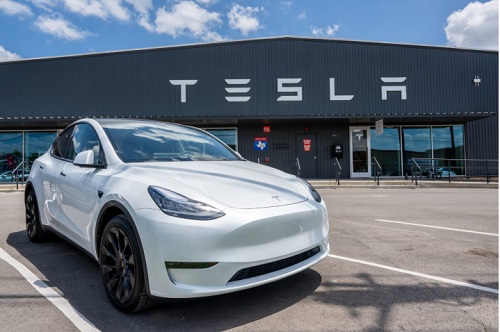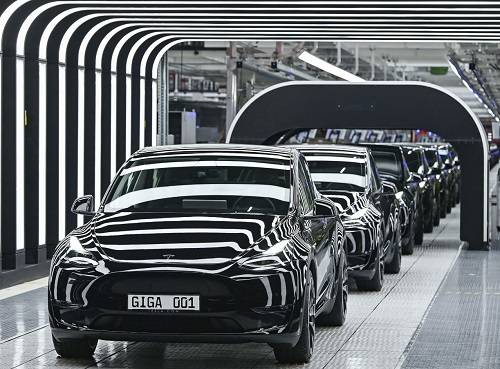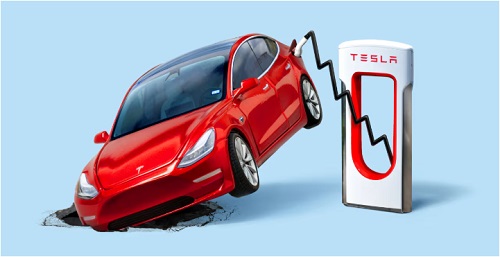Tesla experienced its first annual decline in deliveries, reporting fewer electric vehicle handovers than anticipated in the fourth quarter, alongside incentives that failed to invigorate interest in its aging model range. Throughout 2024, the company repeatedly fell short of its quarterly delivery goals.
In 2024, deliveries totaled 1.79 million, which is a 1.1% decrease compared to the previous year, falling short of the projected 1.806 million units based on a poll of 19 analysts conducted by LSEG. In the three months ending December 31, Tesla delivered 495,570 vehicles, missing the expected 503,269 units, according to 15 analysts surveyed by LSEG. The automaker handed over 471,930 Model 3 and Model Y units and 23,640 of its other models, like the Model S sedan, Cybertruck, and Model X SUV. During the October to December period, Tesla manufactured 459,445 vehicles.
The company’s shares dropped 3.5% before the market opened, reflecting investor concerns about the obstacles facing CEO Elon Musk, who had anticipated that promotions such as zero-interest financing would help achieve a “slight growth” in deliveries for 2024. Nonetheless, Tesla’s stock has surged over 60% from a year ago, reaching new highs following the US presidential election and boosting Musk’s wealth to more than $400 billion.
A decline in European subsidies, a US transition to more affordable hybrid cars, and intensified competition from China’s leading EV manufacturer BYD have strained Tesla’s performance. Throughout 2024, the company reported a series of disappointing quarterly earnings, as price reductions and the introduction of a new truck failed to attract customers.
Despite these challenges, investors remain optimistic, especially with Musk’s strong ties to President-elect Donald Trump. Some Tesla owners have expressed remorse regarding their purchases, feeling embarrassed to be seen in the electric vehicles following Musk’s hard-right stance. Additionally, Musk has signaled a willingness to leave the company amidst ongoing legal disputes over his compensation. A judge has dismissed the proposed $56 billion pay package twice, deeming it excessive, even after shareholders approved it.
To address its sales challenges, Musk shifted Tesla’s focus toward self-driving taxis and supported Trump with substantial campaign contributions, hoping to secure regulatory leniency for the company. Musk has contributed nearly $250 million to support Trump’s campaign.
Analysts have noted that with self-driving technology still years away from realization, Tesla will need to depend on more affordable versions of its existing vehicles and the Cybertruck to stimulate sales growth in the short term. The Cybertruck, which features a distinct trapezoidal stainless-steel design, has shown signs of softening demand, according to analysts.
Moreover, the number of Tesla vehicle registrations in Europe fell by 24% in October, largely due to strong competition from Volkswagen Group, whose Skoda Enyaq SUV surpassed the Model Y as the top-selling EV in the region, as reported by the data research firm Jato Dynamics.
To compete with BYD and other manufacturers, Tesla reduced prices on several models last year, which negatively impacted its profit margins on vehicle sales. However, Wall Street anticipates an increase in demand in 2025 as the US Federal Reserve begins to lower interest rates.
For the first time since becoming a public company, Tesla announced a yearly sales decline during its latest report, as rising competition and decreasing demand for electric vehicles influenced the results.
The firm revealed that it sold 495,570 vehicles in the fourth quarter, marking a 2% increase from the prior year. Nevertheless, it significantly lagged behind the 595,413 pure EVs sold by its Chinese competitor BYD during the same quarter. Tesla’s total annual sales of 1.8 million vehicles still narrowly exceeded BYD’s yearly total by 24,000 units, thus retaining the title of the world’s largest EV manufacturer.

Despite this, Tesla’s overall sales for 2024 were down 1% compared to 2023, indicating the first such decline in the company’s history. Previously, Tesla reported annual sales growth rates nearing 50%, with the 2023 figures showing a robust 37% increase over 2022, so even a slight decline marks a notable slowdown.
Tesla has encountered intensified competition not only from Chinese firms like BYD but also from traditional global automakers such as General Motors, Ford, Volkswagen AG, as well as South Korean partners Hyundai and Kia. Although these established manufacturers currently account for only a small share of Tesla’s EV sales, mainly selling gasoline-powered vehicles, they are increasing competitive pressures.
To counter the falling demand, Tesla has been lowering vehicle prices in both China and the United States. The company enjoys a financial edge, being more profitable than its legacy rivals, many of whom are still incurring losses on EV sales as they work to grow sales volume and cut costs.
In general, sales of electric vehicles are still rising, both domestically and internationally, albeit at a slower rate than in previous years.
Shares of Tesla (TSLA) fell more than 4% in early trading on the weak sales report. But they closed 2024 up 68% for the year. Almost all of that gain came after Election Day, as investors bet that Tesla will benefit from policies under the incoming Trump administration, given the key support for the president-elect from CEO Elon Musk.
Increased competition and an aging model range
In 2022, Tesla forecasted a 50 percent growth in its sales each year, but this prediction faced challenges due to an outdated model lineup and heightened competition in China, Europe, and the U.S.
In the U.S., experts indicate that most early technology adopters already possess electric vehicles, while more mainstream consumers express worries about range, pricing, and locating charging stations during long journeys.
The deliveries in the fourth quarter fell below Wall Street’s expectations, as analysts surveyed by FactSet anticipated sales of 498,000 vehicles.
This week, the company attracted attention when a Cybertruck — one of its flagship models — caught fire and exploded outside a Trump hotel in Las Vegas. Authorities discovered firework mortars and camp fuel canisters packed into the vehicle, and Musk stated in a post on X, formerly known as Twitter, that the blast was unrelated to the Cybertruck itself.
A decline in sales early in the year led to unprecedented discounts for the automaker, affecting its leading profit margins in the industry. The competition from both established and new automakers is intensifying as they attempt to capture a share of Tesla’s market.
Daniel Ives, a financial analyst at Wedbush Securities, believes the stock still presents a buying opportunity despite the decrease in sales.
“We have never simply regarded Tesla as a car manufacturer…. instead, we view Musk and Tesla as a dominant player in disruptive global technology,” Ives noted in a communication to clients. “And the initial phase of this comprehensive strategic vision has begun to materialize.”
Although Tesla’s fourth-quarter sales marked a record for the company, they indicate that its aging model range is reaching saturation in the entry-level luxury vehicle sector, according to Seth Goldstein, an analyst at financial services company Morningstar.
Nearly all of Tesla’s vehicle sales were from the more affordable models 3 and Y, with only 23,640 sold from its pricier models, including the X and S, as well as the newly introduced Cybertruck.
Beyond the Cybertruck, which has found limited appeal, Tesla’s latest consumer model is the Y, a compact SUV that launched in 2020.
After CEO Elon Musk anticipated “slight growth” in 2024, Tesla’s 1.1% dip in annual deliveries caused a 6% drop in the company’s stock on January 2, as reported by Reuters.
What caused Tesla to miss expectations? In summary, car buyers aren’t compelled to purchase EVs from Tesla. For them to do so, the company needs to outpace its competitors — many of which experienced significant growth in 2024 shipments.
Various buyer demographics have distinct motivations for choosing Tesla EVs. For example, early adopters endured numerous technical difficulties, as highlighted in a July 2020 Forbes article, for the prestige of being the first to own an EV. Analysts have mentioned that this group has largely completed their EV purchases.
Conversely, most mainstream consumers are less enthusiastic. They have expressed “concerns about range, price, and the ability to locate charging stations during extended journeys,” as noted by the Associated Press.
Between 2014 and 2023, Tesla’s yearly EV shipments grew at an average annual rate of 56.7%, based on my analysis of data obtained from Reuters.
This prompts questions for investors: Why did Tesla’s rapid growth turn negative? Can Tesla’s revenues accelerate once again? If not, will Tesla stock — which surged 74% in 2024 — continue to rise?
The concise answers are: I identify at least five factors contributing to the slowdown. Revenues can only rebound if Tesla provides a compelling reason for consumers to choose them over competitors, and as long as Musk remains popular and influential, Tesla’s stock could continue to climb.
In 2024, Tesla’s EV shipments decreased — falling short of investors’ growth expectations of approximately 1%.
Specifically, Tesla delivered 1.79 million EVs in 2024 — 1.1% less than the 1.81 million in 2023 and 16 million fewer than the “estimates of 1.806 million units from 19 analysts surveyed by the London Stock Exchange Group,” as noted by Reuters.

Here is my initial Five-Whys analysis:
- Why did Tesla’s 2024 EV shipments decrease? The year-end incentives for Tesla’s outdated lineup — such as interest-free financing and complimentary fast-charging — and the new Cybertruck pickup did not attract customers, according to Reuters.
- Why did Tesla’s incentives and the Cybertruck not attract customers? The diminished European subsidies, a transition in the U.S. towards more affordable hybrid vehicles, and increasing competition, particularly from BYD in China, overshadowed Tesla’s incentive appeal, Reuters reported.
- Why did consumers turn to hybrid vehicles and BYD EVs? Shoppers gravitated towards hybrids due to their affordability, practicality, and a favorable balance between fuel efficiency and the dependability of a gasoline engine. Concerns about an EV’s charging infrastructure, range anxiety, and higher price points during economic uncertainty also played a role, as Urban Science indicated. Furthermore, BYD experienced a 12.1% increase in EV deliveries — surpassing the EV market’s 7.2% growth through September 2024 — achieving 1.76 million in 2024, according to Reuters.
- What caused BYD’s electric vehicle expansion to outpace that of Tesla? BYD capitalizes on vertical integration, economies of scale, and advanced battery technology, allowing it to present consumers with more innovative designs at lower costs than Tesla — a factor that deters some potential buyers who do not align with Musk’s political beliefs, Campaign Asia reported.
- Why hasn’t Tesla adapted to the shifting consumer preferences that have increased interest in hybrids and BYD’s products? Tesla — which anticipates a sales growth of 20% to 30% in 2024 — is focused on promoting self-driving taxis instead of targeting customers from lower-income brackets. To meet its growth predictions, Tesla needs to provide vehicles priced in the “mid $30,000s to attract more mainstream buyers contemplating gas, electric, or hybrid vehicles,” Morningstar Analyst Seth Goldstein told AP. Musk’s alignment with President-elect Donald Trump “may be alienating some buyers who are more environmentally aware and inclined towards Democrats,” said automotive research vice president Jeff Schuster of Global Data to AP. Musk has stated he intends to leverage his position in the Trump administration to advocate for federal — instead of state-specific — approval of autonomous vehicles, as reported by Reuters.
Can Tesla regain its rapid revenue growth?
Analysts are split on the timeline and likelihood of Tesla accelerating its growth. “We have never considered Tesla to be just an automotive company,” noted Wedbush financial analyst Daniel Ives in a report highlighted by AP.
Ives added that Tesla “stock should be assessed more for its potential in creating fully autonomous and self-driving vehicles, along with its AI innovations, and remains a viable investment despite a decline in sales. We have continually regarded Musk and Tesla as key disruptive forces in global technology, and the initial phase of this grand strategic vision is already emerging.”
Goldstein and Schuster argue that Tesla’s target of 20% to 30% revenue growth by 2025 is unlikely to be met. Ultimately, with Musk focusing more on self-driving taxis — which are improbable to launch by 2025 — Tesla may have difficulty reaching that target.
Despite claims to introduce a more affordable electric vehicle this year, Tesla has not made significant strides toward this goal. Tesla announced the intention to “start selling a vehicle in 2025 for as low as $25,000,” according to the New York Times. Nonetheless, Tesla has not showcased a prototype, nor has Musk shared many specifics about the initiative, as the Times observed.
Unless Tesla accelerates production of these models imminently, it remains uncertain how the company will achieve notable growth this year.
What are the prospects for Tesla stock? Analysts consider Tesla’s stock to be overvalued. Based on the projections of 33 Wall Street analysts offering 12-month price targets, Tesla shares would need to decrease by approximately 28% to align with the average target of $292.03, as reported by TipRanks.
Here are four analyst perspectives:
- Tesla’s earnings do not warrant its current stock price. Leonard Kostovetsky, an associate professor at Baruch College’s Zicklin School of Business, remarked to the Times that Tesla “is not generating nearly sufficient profits to justify the stock price,” asserting, “People are rationalizing it based on future developments.”
- Tesla’s market capitalization is greater than that of the subsequent 20 largest automakers combined. According to data from S&P Global Market Intelligence cited in the Wall Street Journal, Tesla’s market cap stands at $1.2 trillion, which surpasses that of the next 20 largest car manufacturers combined.
- Two-thirds of Tesla’s market valuation relies on pure potential. Last month, when Tesla’s market cap peaked over $1.5 trillion, it was estimated that roughly $1 trillion of that value was anticipated from “future revenues,” according to Evercore ISI analyst Chris McNally in the Journal’s analysis.
- Tesla stock could decline as its valuation is outpacing its fundamentals. Momentum and speculative enthusiasm are influencing Tesla’s stock, which is likely to enter a “downward trend,” reflecting past instances where the company’s market valuation significantly exceeded its fundamentals, as noted in a November report from UBS analyst Joseph Spak.
As long as Musk holds considerable political influence, Tesla’s share price may increase. Otherwise, investors should be cautious.



